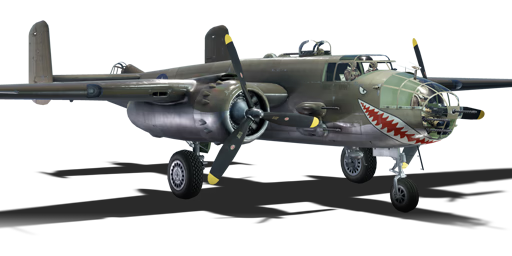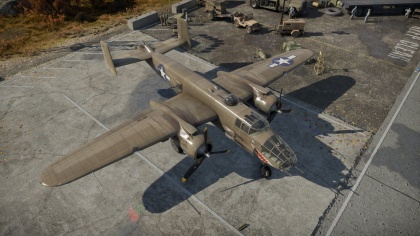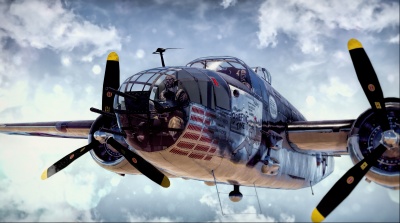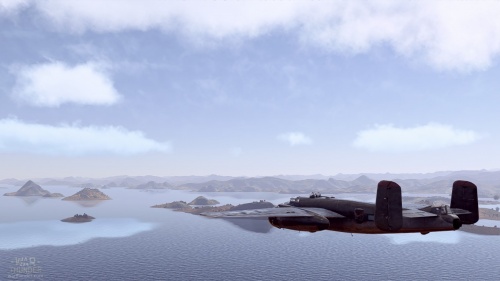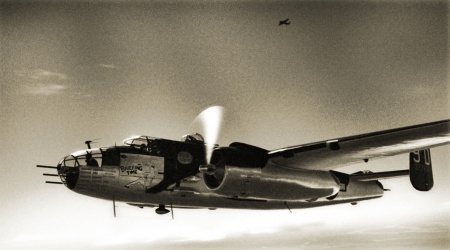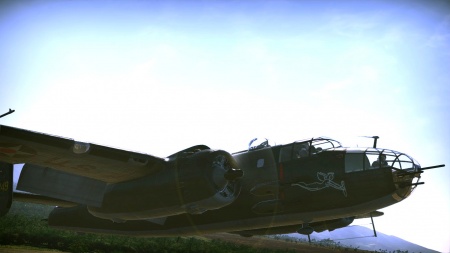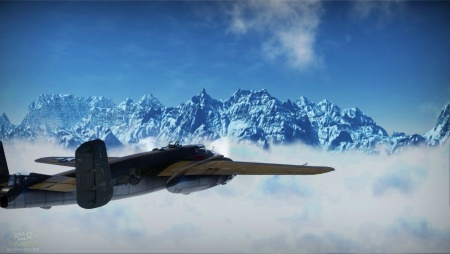Difference between revisions of "B-25J-20"
(Added history section.) |
(→Pros and cons) (Tag: Visual edit) |
||
| Line 141: | Line 141: | ||
The '''''{{PAGENAME}}''''' is armed with: | The '''''{{PAGENAME}}''''' is armed with: | ||
| + | |||
* 2 x 12.7 mm Browning M2 machine guns, nose-mounted (400 rpg = 800 total) | * 2 x 12.7 mm Browning M2 machine guns, nose-mounted (400 rpg = 800 total) | ||
* 4 x 12.7 mm Browning M2 machine guns, cheek-mounted (400 rpg = 1,600 total) | * 4 x 12.7 mm Browning M2 machine guns, cheek-mounted (400 rpg = 1,600 total) | ||
| Line 152: | Line 153: | ||
The '''''{{PAGENAME}}''''' can be outfitted with the following ordnance: | The '''''{{PAGENAME}}''''' can be outfitted with the following ordnance: | ||
| + | |||
* 12 x 100 lb AN-M30A1 bombs (1,200 lb total) | * 12 x 100 lb AN-M30A1 bombs (1,200 lb total) | ||
* 4 x 250 lb AN-M57 bombs (1,000 lb total) | * 4 x 250 lb AN-M57 bombs (1,000 lb total) | ||
| Line 167: | Line 169: | ||
The '''''{{PAGENAME}}''''' is defended by: | The '''''{{PAGENAME}}''''' is defended by: | ||
| + | |||
* 1 x 12.7 mm Browning M2 machine gun, nose turret (300 rpg) | * 1 x 12.7 mm Browning M2 machine gun, nose turret (300 rpg) | ||
* 2 x 12.7 mm Browning M2 machine guns, dorsal turret (400 rpg = 800 total) | * 2 x 12.7 mm Browning M2 machine guns, dorsal turret (400 rpg = 800 total) | ||
| Line 241: | Line 244: | ||
'''Pros:''' | '''Pros:''' | ||
| + | |||
* Very effective front-facing armament of 6 x 12.7 mm machine guns allows for engaging enemy bombers at the start of the match, or incoming fighters | * Very effective front-facing armament of 6 x 12.7 mm machine guns allows for engaging enemy bombers at the start of the match, or incoming fighters | ||
| − | * Durable airframe | + | * Durable airframe which can take a beating from weak guns like 20mm Type 99 |
* Heavy defensive armament on both left and rights sides and especially on the rear | * Heavy defensive armament on both left and rights sides and especially on the rear | ||
* Can provide initial cover for other bombers until fighters reach their altitude | * Can provide initial cover for other bombers until fighters reach their altitude | ||
| − | * Can be used as | + | * Can be used as a tactical bomber, strategic bomber, attacker or even an interceptor |
* Able to land on an aircraft carrier | * Able to land on an aircraft carrier | ||
| + | * Rather fast dive acceleration | ||
'''Cons:''' | '''Cons:''' | ||
| − | * | + | |
| − | * | + | * Manoeuvres stiffly, cannot turnfight |
| − | * | + | * Rudder severely locks up over 400kph, meaning it cannot adjust its aim in time and need a second pass. |
| − | * | + | * Difficult to pull out of a dive due to elevator lockup. |
| − | * | + | * Often the fuel tank in wings will catch fire, leading to the failure of spars. |
| − | * | + | * No downward-facing defensive armament |
| + | * If tail control is damaged, return to base and land utilizing flaps and engine throttling | ||
| + | * Relatively low payload compared to a heavy bomber | ||
| + | * Forward facing gunner will automatically fire at approx 1,000 m, alerting your target | ||
| + | * Low energy retention; any attacks that require manoeuvring will cost speed and altitude | ||
== History == | == History == | ||
| Line 286: | Line 295: | ||
== Media == | == Media == | ||
<!--''Excellent additions to the article would be video guides, screenshots from the game, and photos.''--> | <!--''Excellent additions to the article would be video guides, screenshots from the game, and photos.''--> | ||
| + | |||
;Videos | ;Videos | ||
{{Youtube-gallery|NuU-Vz0UqMc|'''B-25J-20 Mitchell [Rugged Versatility!]''' - ''Jengar''}} | {{Youtube-gallery|NuU-Vz0UqMc|'''B-25J-20 Mitchell [Rugged Versatility!]''' - ''Jengar''}} | ||
| Line 294: | Line 304: | ||
* ''reference to the series of the aircraft;'' | * ''reference to the series of the aircraft;'' | ||
* ''links to approximate analogues of other nations and research trees.''--> | * ''links to approximate analogues of other nations and research trees.''--> | ||
| + | |||
;Aircraft of comparable role, configuration and era | ;Aircraft of comparable role, configuration and era | ||
| + | |||
* de Haviland [[Mosquito (Family)|Mosquito]] | * de Haviland [[Mosquito (Family)|Mosquito]] | ||
* Douglas [[DB-7 (Family)|DB-7]] and its many derivatives (such as [[A-20G-25|A-20G]]) | * Douglas [[DB-7 (Family)|DB-7]] and its many derivatives (such as [[A-20G-25|A-20G]]) | ||
| Line 301: | Line 313: | ||
;Other B-25 variants in-game | ;Other B-25 variants in-game | ||
| + | |||
* [[B-25J-1]] - Very little difference between the J-1 and J-20, the J-1 has one less nose-mounted machine gun, slight armour difference. | * [[B-25J-1]] - Very little difference between the J-1 and J-20, the J-1 has one less nose-mounted machine gun, slight armour difference. | ||
* [[B-25J-30_(China)|B-25J-30]] (Chinese lend-lease) - Virtually same as J-20 variant. | * [[B-25J-30_(China)|B-25J-30]] (Chinese lend-lease) - Virtually same as J-20 variant. | ||
| Line 312: | Line 325: | ||
* ''encyclopedia page on the aircraft;'' | * ''encyclopedia page on the aircraft;'' | ||
* ''other literature.'' --> | * ''other literature.'' --> | ||
| + | |||
* [[wikipedia:Doolittle_Raid|[Wikipedia<nowiki>]</nowiki> Doolittle Raid]] | * [[wikipedia:Doolittle_Raid|[Wikipedia<nowiki>]</nowiki> Doolittle Raid]] | ||
{{AirManufacturer NAA}} | {{AirManufacturer NAA}} | ||
{{USA bombers}} | {{USA bombers}} | ||
Revision as of 10:20, 30 May 2020
Contents
| This page is about the American bomber B-25J-20. For other versions, see B-25 (Family). |
Description
The B-25J-20 Mitchell is a rank American bomber
with a battle rating of (AB), (RB), and (SB). It was introduced in Update 1.29.
Design of the B-25 was the result of years of work and failed bids to win contracts with the United States Army Air Corps (USAAC). Initially designed to meet requirements for a payload of 1,200 lb (540 kg), a range of 1,200 mi (1,900 km) and flying at speeds faster than 200 mph (320 kph), prototypes were built, tested and refined. Although the original XB-21 and NA-40 never materialized into a production aircraft, requirements from the USAAC came out in March of 1939 for a medium bomber carrying a payload of 2,400 lb (1,100 kg) over 1,200 mi (1,900 km) at speeds around 300 mph (480 kph), North American modified their design of NA-40 and developed the NA-62 which went into prototype testing as the YB-25 and then ordered into production as the B-25.
The B-25 turned out to be the archetype of the medium bomber, carrying upwards of 3,000 lb (1,361 kg) of bombs and could fly at speeds up to 340 mph (547 kph). This twin-engine bomber was fast, it could carry a large payload for its size and had several defensive turrets and gunner stations at which it could defend itself from almost any angle. To increase its versatility, several models had forward-facing fixed machine guns fitted into the nose and the cheeks of the aircraft. Later models opted to removed the glazed nose and bombardier/nose-gunner station and outfit more machine guns and even a 75 mm autocannon for strafing ground targets and especially ships. This medium bomber at times acted more like a heavy attacker opting for low-level flights which would skim treetops and the ocean to sneak up on unwary targets. It was not uncommon for B-25s to fly just above the mast/smokestack height of enemy ships when attacking.
As later models moved from the dedicated bomber position and morphed into more of an attacker role, bomb payloads were reduced to allow for more armour around the cockpit and more offensive weapons and ammunition to fill the attacker mode it took on, especially under the command of U.S. Marine Corps squadrons. With more than 10,000 B-25 aircraft variants built, they saw action in all theatres of war and were even subject to part of the lend-lease program which China and the USSR benefitted from. So versatile was this aircraft that a flight of them were specifically outfitted and their crews trained to take off from an aircraft carrier and bomb mainland Japan in a daring raid. Impressive for an aircraft not meant to take off from an aircraft carrier.
The B-25 is a fantastic bomber, attacker or both and will suit many different pilots and their different approaches to the battlefields found in War Thunder. The tail gunner has been known to set many fighters alight with their dual .50 calibre machine guns and help to prolong the life of this bomber to allow the pilot to make it to their target whether it is to bomb it or strafe it.
General info
Flight performance
| Characteristics | |||||||
|---|---|---|---|---|---|---|---|
| Stock | |||||||
| Max Speed (km/h at 3,049 m) |
Max altitude (meters) |
Turn time (seconds) |
Rate of climb (meters/second) |
Take-off run (meters) | |||
| AB | RB | AB | RB | AB | RB | ||
| 420 | 407 | 32.4 | 33.8 | 5.4 | 5.3 | 750 | |
| Upgraded | |||||||
| Max Speed (km/h at 3,049 m) |
Max altitude (meters) |
Turn time (seconds) |
Rate of climb (meters/second) |
Take-off run (meters) | |||
| AB | RB | AB | RB | AB | RB | ||
| 472 | 444 | 29.7 | 31.0 | 10.6 | 7.7 | 750 | |
Details
| Features | ||||
|---|---|---|---|---|
| Combat flaps | Take-off flaps | Landing flaps | Air brakes | Arrestor gear |
| ✓ | ✓ | ✓ | X | X |
| Limits | ||||
|---|---|---|---|---|
| Wing-break speed (km/h) |
Gear limit (km/h) |
Combat flaps (km/h) |
Max Static G | |
| + | - | |||
| 430 | ~4 | ~2 | ||
| Optimal velocities | |||
|---|---|---|---|
| Ailerons (km/h) |
Rudder (km/h) |
Elevators (km/h) |
Radiator (km/h) |
| < 270 | < 320 | < 350 | > 320 |
| Compressor (RB/SB) | ||
|---|---|---|
| Setting 1 | ||
| Optimal altitude | 100% Engine power | WEP Engine power |
| 1,676 m | 1,700 hp | 1,850 hp |
| Setting 2 | ||
| Optimal altitude | 100% Engine power | WEP Engine power |
| 4,115 m | 1,450 hp | N/A |
Survivability and armour
- 10 mm steel - front, sides & rear of the cockpit
- 10 mm steel - the rim of pilot seats
- 8 mm steel - below nose gunner
- 8 mm steel - pilot seats
- 9.5 mm - bulkhead after of dorsal turret
- 6.35 mm steel - aft of waist gunners
- 9.5 mm steel - tail turret
- 38 mm bulletproof glass - tail turret
Rugged, sturdy, though, the B-25 is all of those things. Featuring crew armour protection that outclasses the B-17 Flying Fortress in a handier, smaller design, the Mitchell is a tough nut to crack and even harder to devoid of the crew. Calibres above 20 mm are a must for a quick kill, otherwise, the B-25 will repay in kind. Gunner positions throughout the bomber effectively cover the front, sides, top and rear of the aircraft with just the underbelly left relatively unprotected to fighters rising in a power climb. The rear gunner with his dual .50 calibre machine guns is especially devastating when they are trained on a tailing enemy fighter.
The two Wright R-2600 air-cooled radial engines are themself hard to destroy and with dropped payload, the Mitchell can keep flying on just a single damaged engine, denying under armed fighters the ability to lethally cripple it. Yet this aircraft does have an Achilles heel, its fuel tanks. While present in all planes, the armour, crew and bomb bay take up all the necessary space within the fuselage, while leaving only space in the wings to house the fuel tanks. A common downfall of this aircraft is the structural failure of the wing spar due to wing fires of the fuel tanks.
Armaments
Offensive armament
The B-25J-20 is armed with:
- 2 x 12.7 mm Browning M2 machine guns, nose-mounted (400 rpg = 800 total)
- 4 x 12.7 mm Browning M2 machine guns, cheek-mounted (400 rpg = 1,600 total)
Intended for strafing ground targets the sextuple AN/M2 heavy machine guns do an excellent job. Situated in the nose and along the cheeks, the firepower is not as concentrated as on the A-20G or A-26 Invader, but quite better than on many US fighter designs. And many potential interceptors quickly realised this difference, too. Unlike with wing placed armament which has to contend with gun convergence, the nose-mounted design always aims true in the horizontal. Thus fire can be opened at any range and as the B-25 is blessed with a substantial amount of ammunition can afford to miss. Head-ons are hence more often than not a sure-fire bet for the Mitchell quite unlike for a medium bomber.
Dousing an enemy in gunfire sure looks impressive with the B-25's Tracers belt. A shame all versions only receive the pre-war M1 Tracer bullet in their belts. The true champion in destruction power and fire chance is the M8 AP-I bullet found in the Omni-Purpose and Stealth belts. Both come recommended for any use, may it be air, ground or naval. The M2 AP bullet found in the Ground belt adds little in penetration and may safely be foregone even in Mixed battles for the flexibility the other two belts offer.
Suspended armament
The B-25J-20 can be outfitted with the following ordnance:
- 12 x 100 lb AN-M30A1 bombs (1,200 lb total)
- 4 x 250 lb AN-M57 bombs (1,000 lb total)
- 4 x 250 lb AN-M57 bombs + 8 x 100 lb AN-M30A1 bombs (1,800 lb total)
- 8 x 250 lb AN-M57 bombs (2,000 lb total)
- 2 x 500 lb AN-M64A1 bombs + 8 x 100 lb AN-M30A1 bombs (1,800 lb total)
- 4 x 500 lb AN-M64A1 bombs (2,000 lb total)
- 1 x 1,000 lb AN-M65A1 bomb + 10 x 100 lb AN-M30A1 bombs (2,000 lb total)
- 3 x 1,000 lb AN-M65A1 bombs (3,000 lb total)
Featuring a wide variety of options the B-25 offers a payload for every job. Triple one thousand pounders for bases or medium altitude pillbox hunting, quadruple five hundred pounders for low altitude pillbox and heavy tank strafing and the eigth times two hundred fifties for convoy soft targets or medium tanks. But please do not forget to set a fuse timer before spawn, if going for a low altitude strafing run.
Defensive armament
The B-25J-20 is defended by:
- 1 x 12.7 mm Browning M2 machine gun, nose turret (300 rpg)
- 2 x 12.7 mm Browning M2 machine guns, dorsal turret (400 rpg = 800 total)
- 1 x 12.7 mm Browning M2 machine gun, 2 x beam turrets (250 rpg)
- 2 x 12.7 mm Browning M2 machine guns, tail turret (600 rpg = 1,200 total)
The defensive fire of the B-25 quite excellent, but only quite. The rearward field of fire of the dorsal and tail turret overlap significantly and are a serious concern for even heavy fighters. The beam turrets have decent vertical arcs and about 45° starting from the rudder. For whatever reason the B-25 maintains a nose gunner, too, despite blistering with offensive heavy machine guns. Intended for use in formation flight, the nose gunner offers little benefit in-game except for further demonstrating the concept of overkill.
However, the defensive firing arcs have a blindspot: The belly. Starting from around -20° the tail gunner can no longer take aim at any pursuit aircraft. Its horizontal arc is also very limiting only encompassing about 10° total. This leaves not only the belly open, but also an approach window 15° offset from the tail where both the beam and tail gunner cannot aim. While the latter is easily resolved with a slight change of direction, the former is the true weak spot of the B-25 and found on all derivatives. This makes it sadly a rather well-known weakness, too.
Usage in battles
The airframe makes this plane a particularly difficult target to bring down, however, there are four main blind spots to be considered: Level with the leading edges of the wings, the complete underside, and each side in the rear presented by the twin tail. These are the easiest areas to kill an opposing B-25. With a max speed of 444 km/h (275 mph) under ideal conditions and a max airframe speed of 580 km/h (360 mph), the B-25 is relatively fast for a bomber, but while climbing, can go no faster than 280 km/h (175 mph) with optimal pitch. The twin engines make for good acceleration and allow the plane to get to an airfield to land, given you are at altitude and can maintain airspeed.
This plane makes a great strategic bomber, but its wings make for nice large targets. The best way to ward off enemy fighters is to bank in toward them, giving your top gunner a chance to damage them before they can cause any real damage. Always try to fly at treetop level to cover the blind spot on the underside, or fly with bombers that have belly gunners, so you are fully covered. Also try to fly with friendly fighters, as they will prove invaluable to your survival. If you wind up with an enemy fighter or attacker on your tail, reduce engine power and adjust trim so you retain level flight, but give all rear-facing gunners the ability to damage your opponent. Never fly in a straight line while fending off attackers!!
Manual Engine Control
| MEC elements | ||||||
|---|---|---|---|---|---|---|
| Mixer | Pitch | Radiator | Supercharger | Turbocharger | ||
| Oil | Water | Type | ||||
| Controllable | Controllable Not auto controlled |
Not controllable Not auto controlled |
Controllable Auto control available |
Separate | Controllable 2 gears |
Not controllable |
Modules
| Tier | Flight performance | Survivability | Weaponry | ||
|---|---|---|---|---|---|
| I | Fuselage repair | Radiator | Protective vest | Offensive 12 mm | SBC-25 |
| II | Compressor | Airframe | New 12 mm MGs | MBC-25 | |
| III | Wings repair | Engine | Turret 12 mm | ||
| IV | Engine injection | Cover | New 12 mm MGs (turret) | LBC-25 | |
Pros and cons
Pros:
- Very effective front-facing armament of 6 x 12.7 mm machine guns allows for engaging enemy bombers at the start of the match, or incoming fighters
- Durable airframe which can take a beating from weak guns like 20mm Type 99
- Heavy defensive armament on both left and rights sides and especially on the rear
- Can provide initial cover for other bombers until fighters reach their altitude
- Can be used as a tactical bomber, strategic bomber, attacker or even an interceptor
- Able to land on an aircraft carrier
- Rather fast dive acceleration
Cons:
- Manoeuvres stiffly, cannot turnfight
- Rudder severely locks up over 400kph, meaning it cannot adjust its aim in time and need a second pass.
- Difficult to pull out of a dive due to elevator lockup.
- Often the fuel tank in wings will catch fire, leading to the failure of spars.
- No downward-facing defensive armament
- If tail control is damaged, return to base and land utilizing flaps and engine throttling
- Relatively low payload compared to a heavy bomber
- Forward facing gunner will automatically fire at approx 1,000 m, alerting your target
- Low energy retention; any attacks that require manoeuvring will cost speed and altitude
History
Early in 1939 as tensions were rising throughout Europe, the Soviet Union and Asia, the United States Army Air Corps (USAAC) issued requirements for a new medium bomber contract. Specifications for the medium bomber included carrying a payload of 2,400 lb (1,100 kg) while flying over 1,200 mi (1,900 km) at a speed of 300 mph (480 km/h). Fortuitously North American Aviation (NAA) already had a previous design for their NA-40B which they had already built as a prototype known as NA-62. After initial service tests, the USAAC placed an order with NAA to produce the NA-62 as the B-25. Alongside the B-25, the USAAC also ordered the Martin B-26 Marauder into production, though it was still only drawings on paper.
NAA had a head start through utilising their existing NA-62 aircraft. Initially, the plane had a constant-dihedral or and upward angle to the main wings. Unfortunately, this configuration caused stability issues which resolved when the wing shape became slightly anhedral just from the engine nacelle to the wingtip. The flattening of the outer wing led the aircraft to have gull shaped wings; however, this eliminated any stability problems previously encountered. Though not as noticeable was the increase in the size of the tail fins and decrease their inward tilt. These factors would also help improved stability and increase the aircraft's responsiveness, especially when carrying heavy loads.
Development continued through 1941 and in 1942 the first B-25A and B-25B models reported for duty with the USAAC. Variants of the B-25 from B through H changed over time, and the military experimented with using the aircraft as a bomber and a strafing aircraft specialising in an anti-shipping role with its skip-bombs, 14-18 forward-facing machine guns or even a 75 mm M4 cannon. The B-25J versions of the plane were essentially the same as a B-25H; however the 75 mm cannon was removed, and the nose of the aircraft was changed out. Now there were two versions of the nose which could be field swapped to change the usage of the aircraft. The B-25J-20 strafer version incorporated a metal nose outfitted with eight 12.7 mm Browning machine guns while the second option utilised a glass nose with a single crew usable 12.7 mm Browning and two 12.7 mm Brownings which were fixed and operated by the pilot often in conjunction with four blister mounted 12.7 mm machine guns. This aircraft while developed for mid-level bombing instead excelled as a low altitude strafing bomber, often flying at tree-top levels and at times mast-level with ships. Frequently strafing B-25s lead the charge to eliminate enemy gunners and anti-aircraft instalments while bomber B-25s followed immediately behind to destroy airfields or vessels, often causing havoc at the target site.
In-game description
North American B-25J-20 Mitchell twin-engine medium bomber/ground-attack aircraft
As its mass production progressed, the B-25J was continually improved, but in most cases this concerned the aircraft's equipment or armament and not its airframe or power unit. Aircraft of the B-25J-5 series had new multi-purpose N-3C gunsights (everywhere but on the waist turrets) and a newly introduced alcohol windshield washing system for the pilot's cockpit. Also, blast reducers were installed on the barrel muzzles of the upper and waist machine guns.
Aircraft of the B-25J-10 series were equipped with external bomb racks under the wings. The heaters at the waist gun positions were found to be inefficient and were no longer installed.
Replacement of the sights was completed with the B-25J-15 bombers; now, the waist turrets were also equipped with the new N-8A optical sights. In addition, a backup iron sight was installed for the pilots. All machines of these series were produced with one fixed machine gun in the bombardier's cockpit.
Aircraft of the B-25J-20 series had a second fixed 12.7 mm Colt-Browning ANM2.5 machine gun, with 400 rounds of ammunition, mounted in the bombardier's cockpit. An additional armor plate was provided in the floor under the bombardier's seat. The cap glazing of the upper turret was reinforced. The mobile 12.7 mm Colt-Browning ANM2.5 machine gun in the front cockpit was shifted upward slightly so that the ammunition box of the second fixed machine gun would not interfere with its operation.
An emergency brake system was also installed. Beginning with machine No. 44-29340, Holley 1685RB carburettors were fitted on the bomber's engines.
A Norden M-9 bombsight was mounted on the aircraft built for the USAAF, and a simpler Wimperis D-8 on the machines to be exported. In the USSR, locally produced OPB-1 (daylight version) and NKPB-7 (night version) bombsights were mounted on В-25s.
In addition, В-25 aircraft in the Soviet Union were equipped with an inert (exhaust) gas fire suppression system for the fuel tanks.
B-25J aircraft were not only supplied to the USAAF. 314 machines were delivered to the British RAF, where they were operated under the designation of Mitchell Mk.III. It was under the Lend-Lease Agreement that these bombers were also supplied to the USSR, Canada, Australia, and China. After the war, В-25Js were supplied to France, the Netherlands, Peru, Venezuela, and Indonesia.
Media
- Videos
See also
- Aircraft of comparable role, configuration and era
- de Haviland Mosquito
- Douglas DB-7 and its many derivatives (such as A-20G)
- Douglas A-26 Invader
- Tupolev Tu-2
- Other B-25 variants in-game
- B-25J-1 - Very little difference between the J-1 and J-20, the J-1 has one less nose-mounted machine gun, slight armour difference.
- B-25J-30 (Chinese lend-lease) - Virtually same as J-20 variant.
- B-25J-30 (Soviet lend-lease) - Same as Chinese lend-lease version with the exception it utilises Soviet bombs.
- PBJ-1H - U.S. Marine variant - 75 mm autocannon and eight nose-mounted machine guns, lower service ceiling, reduced bomb load compared to J-1, J-20 and J-30 variants, increased armour around the cockpit.
- PBJ-1J - U.S. Marine variant - Identical to PBJ-1H in-flight characteristics and bomb loadout, no 75 mm cannon, a total of 12 nose-mounted machine guns.
External links
| North American Aviation | |
|---|---|
| Fighters | |
| P-51A | P-51 · P-51A |
| P-51C | P-51C-10 |
| P-51D | P-51D-5 · P-51D-10 · P-51D-20-NA · P-51D-30 |
| P-51H | P-51H-5-NA |
| Twin-engine fighters | F-82E |
| Jet fighters | F-86A-5 · F-86F-2 · F-86F-25 · F-86F-35 · F-100D |
| Strike aircraft | A-36 · PBJ-1H · PBJ-1J |
| FJ-4B · FJ-4B VMF-232 | |
| Bombers | B-25J-1 · B-25J-20 |
| Export/Licence | ▂B-25J-30 · ␗B-25J-30 |
| ▄Mustang Mk IA · F-6C-10-NA · ␗P-51C-11-NT · ␗P-51D-20 · J26 David · J26 · P-51D-20-NA · ␗P-51K | |
| F-86F-30 ▅ · ␗F-86F-30 · F-86F-40 ▅ · F-86F-40 JASDF▅ · ␗F-86F-40 | |
| ◄F-86K · ▄F-86K (Italy) · ▄F-86K (France) | |
| ␗F-100A · ▄F-100D · ␗F-100F | |
| Captured | ▅P-51C-11-NT |
| Canadair Limited license-built the F-86 as the CL-13 for use in Canada and export to Europe. | |
| Fiat license-built the F-86K for the Italian Air Force though another 120 NAA built F-86Ks were also sold to the Italians. | |
| See Also | Mitsubishi Heavy Industries · Canadair Limited · Fiat Aviation |
| USA bombers | |
|---|---|
| Dive | SB2U-2 · SB2U-3 · SBD-3 · SB2C-1C · SB2C-4 |
| Torpedo | TBD-1 · PBY-5 Catalina · PBY-5A Catalina · TBF-1C · BTD-1 |
| Medium | B-10B · B-18A · B-34 · PV-2D · B-25J-1 · B-25J-20 · A-26C-45 · A-26C-45DT · B-26B |
| Heavy | B-17E · B-17E/L · B-17G-60-VE · PB4Y-2 · B-24D-25-CO · B-29A-BN |
| Hydroplanes | OS2U-1 · OS2U-3 · PBM-1 "Mariner" · PBM-3 "Mariner" · PBM-5A "Mariner" |


